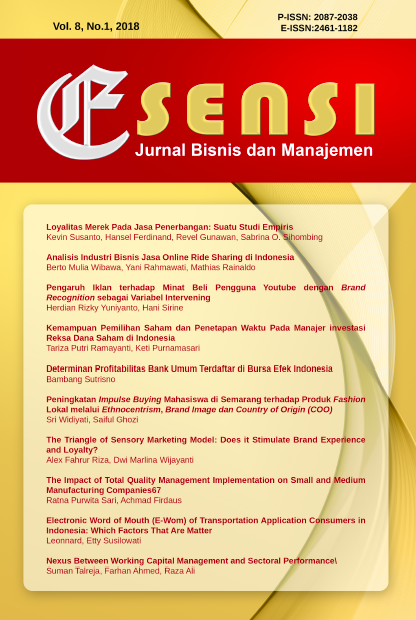Peningkatan Impulse Buying Mahasiswa di Semarang terhadap Produk Fashion Lokal melalui Ethnocentrisme, Brand Image dan Country of Origin (COO)
DOI:
https://doi.org/10.15408/ess.v8i1.6979Keywords:
country of origin ( COO), brand image, ethnocentrism, impulse buyingAbstract
Improvement of Impulse Buying Students in Semarang on Local Fashion Products Through Ethnocentrism, Brand Image, and Country of Origin (COO)
Impulse buying is a very interesting phenomenon for retailers and marketers because it is the biggest market share and occupy a very important position and can increase sales. The aim of the research is to analyze whether the Country of Origin ( COC), brand image and ethnocentrism significantly affect students impulse buying of local fashion in Semarang city. Data analysis used in this research is linier regression analysis. The result shows that COO the only variables that do not significantly affect students impulse buying. Need a strategy of brand image reinforcement and promotion emphasized on the love of domestic products. Promotion of products at the local level of Semarang city needs to be improved by taking into account the values of excellence and local wisdom.
References
Arifianti, R. (2016). Pengaruh Promosi Penjualan Terhadap Impulse Buying Pada Hypermarket Di Kota Bandung. diperoleh dari: http://asm.ariyanti.ac.id/ download/Karya%20Ilmiah/Nomor%205%20Tahun%20III/Pengaruh%20Promosi%20Penjualan%20Trhdp%20Impulse%20Buying%20-%20Ria%2 0Arifianti.doc.
Bhakar, S. S., Bhakar, S., & Bhakar, S. (2013). Relationship Between Country of Origin, Brand Image, and Customer Purchase Intentions. Far East Journal of Psychology and Business. Vol. 10(2): 25–47.
Das, M., & Saha, V. (2017). A Study on Consumer Ethnocentrism and Social Comparison in Rural India: Implications for Marketing Strategy. South Asian Journal of Management. Vol. 24 (1). available at: SSRN: https://ssrn.com/abstract=2941330.
Dholakia, U. . (2013). Temptation and Resistance: An Integrated Model of Consumption Impuls Formulation and Enchanced in Psycology Marketing. Far East Journal of Psychology and Business, 10(2), 25–47.
Ghozali, I. (2006). Aplikasi Analisis Multivariate dengan Program Aplikasi SPSS. Semarang: BP Undip.
Hamin, & Elliott, G. (2006). A Less‐developed Country Perspective of Consumer Ethnocentrism and “Country of Origin” Effects: Indonesian Evidence. Asia Pacific Journal of Marketing and Logistics. Vol. 18(2): 79–97. doi: https://doi.org/10.1108/13555850610658246.
Hoeffler, S., & Keller, K. L. (2003). The Marketing Advantages of Strong Brands. The Journal of Brand Management. Vol. 10(6): 421–445.
Karbasivar, A., & Yarahmadi, H. (2011). Evaluating Effective Factors on ConsumerImpulse Buying Behavior. Asian Journal of Business Management Studies. Vol. 2(4): 174–181.
Khasawneh, K., & Hasouneh, A. B. . (2010). The Effect of Familiar Brand Names on Consumer Behaviour: a Jordanian Perspective. International Research Journal of Finance Economics. Vol. 43(1): 34–57.
Levy, G. (2001). Manajemen Ritel, Edisi Indonesia. Jakarta: Gramedia Pustaka Utama.
Suki, N. M. (2013). Students’ Demand for Smartphones: Structural Relationships of Product Features, Brand Name, Product Price and Social Influence. Campus-Wide Information Systems. Vol. 30(4): 236–248. doi: https://doi.org/10.1108/CWIS-03-2013-0013
Swati K, Sandeep S, Umrikheda V, & Road B, S. M. (2012). Study on The Three Way Influence of Self Concept, Ethnocentrism and Impulsiveness on Consumer’s Exploratory Tendencies. Asian Journal of Management Research. Vol. 3(1): 139–152.
Wanninayake, W. M. C. ., & Dissanayake, D. M. . (2009). Impact of Developing Ethnocentric Brand Templates to Sustain the Lokal Brand-an Empirical Studi. In International Conference of Business Management: 479–490.

